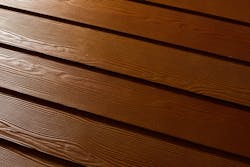Build-in Durability with Pre-Painted Fiber Cement
Opting for fiber cement siding says a lot about your construction practices and desire to build in quality and durability. Choosing to have that fiber cement delivered to the job site pre-painted says even more. In terms of durability, there’s really no comparison between a field-applied finish and one that’s applied in a controlled factory environment. Here’s what makes pre-painted so much better.
You Can’t Get the Secret Sauce.
Fiber cement manufacturers use coatings specially formulated for their specific substrate and application process. Neither you nor your painter can get your hands on it. Unlike your retail paint which is comprised of a clear base tinted at the store with synthetic pigments, the paint formulated for fiber cement manufacturers uses natural color pigments that are ground up to create a monochromatic base. So instead of color being mixed in, the mono-base is the color. These natural color paints are renowned for their superior durability, coverage, stability and resistance to fading. Ancient cave drawing used natural pigments, and they haven’t disappeared after 30,000 years.
Humans Aren’t Robots.
It’s humanly impossible to apply a paint on a vertical surface in outdoor conditions with the same consistency and control you’ll achieve in a cutting-edge painting facility. Factors like wind, a variety of pressure settings in spray equipment, and the painter’s particular technique all add up to the irrefutable fact that achieving a uniform coating across every board is highly unlikely when it’s done on the job.
In a controlled factory setting, paint is applied with a DFT (Dried Film Thickness) target of 1.9 mils. For a field applied paint, a DFT of 1.5 mils would be considered normal. (Not that anyone on a job site is measuring it like they are in the factory.) But the point is an important one. Pre-painted siding not only has a more consistent application of paint, the coating is also thicker.
There’s Junk in the Air.
Tree pollen, leaves, dust, bugs and other airborne debris always finds its way to sticky, freshly painted surfaces. (It’s a law of nature, so to speak.) This isn’t disastrous, of course. Just don’t expect a coating that’s as pristine as one that’s applied and dried inside a state-of-the-art finishing facility.
It Rains Almost Everywhere.
Unless you’re building in the desert, rain is always a concern when painting. Since paint should only be applied to clean, dry surfaces, it’s recommended to wait a full day after a rain to paint. Given the unpredictability of weather, how does that work with your scheduling? Can you afford to hold off a crew for another day? What about squeezing in painting before the predicted rain? That can be risky, since a coat of latex paint needs up to six hours in the sun to withstand a heavy rain.
Humidity Can Be a Bigger Problem.
Let’s suppose you get lucky on the rain. Your luck may run out when it comes to the humidity, since most paint labels recommend painting when the relative humidity is between 40-60%. There are many locations around the country with a limited number of days that fall within this range, especially during peak construction season. There are even some places, like Seattle, where the humidity almost never drops below 60%. Check your local humidity levels. To get the job, you may have to break the humidity rule. Unfortunately, this will also mean you’ll be voiding the paint manufacturer’s warranty.
Oh, and Don’t Forget About the Temperature.
While construction is a year-round endeavor in most parts of the country, painting is not. When temperatures outside are too high or too low, it’s a no-go for painting siding. To create a durable film, the air temperature cannot be above 90 degrees, and the board surface temperature cannot be below 35 degrees. In fact, you can’t even paint if the surface temperature is going to drop below 35 degrees within 48 hours of painting. This isn’t a problem in the factory, of course, where the temperature is ideal for painting 365 days a year.
Your Buyer Will Be Repainting Sooner.
This is a biggie. An on-site paint application simply can’t deliver the same durability as a factory-applied finish. In fact, the pre-painted siding from Allura is guaranteed for 15 years! That’s up to twice the durability of an on-site application, which will likely need to be repainted in 5 to 7 years. (And that’s if it’s applied under optimal conditions, which is uncommon.) With the cost of labor these days, the cost of repainting so much sooner can more than negate any initial savings.
Look, You Wouldn’t Paint a Brand New Car.
What if you had the option to have a new car delivered with just the primer applied? Would you do it? Imagine trying to match that factory finish out in your driveway.
This is exactly the reason why opting for pre-painted siding is such a no-brainer. It’s also a great analogy to use when discussing the pre-painted option with homebuyers. Equating the paint job on siding to the many other things in life that come factory painted—whether it’s a car, a refrigerator or patio furniture—is a quick way to help people understand the difference in the quality of the finish and the level of durability.
When a product can be finished in a controlled factory setting with specially formulated coatings, it will deliver unrivaled results. It’s that simple.
